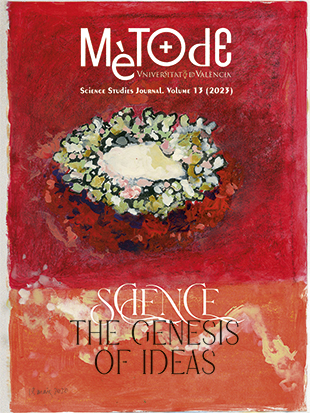Más biodiversidad para mejorar la salud: Los beneficios de favorecer ecosistemas funcionales y diversos en el bienestar humano
DOI:
https://doi.org/10.7203/metode.13.24072Palabras clave:
biodiversidad, prevención, servicios ecosistémicos, una sola salud, zoonosis Resumen
Resumen
Existe una amplia evidencia de que el contacto con la naturaleza produce beneficios medibles en la salud psicológica y fisiológica de las personas. También abundan los estudios que demuestran que ecosistemas bien conservados y con altos niveles de biodiversidad cumplen más funciones, entre ellas la de reducir los riesgos para la salud humana derivados de infecciones de origen animal (zoonosis, como la COVID-19) o del cambio climático. Las Naciones Unidas acuñaron el concepto de una sola salud precisamente para favorecer el estudio multidisciplinar de la salud humana en el contexto global de la salud de animales, plantas y ecosistemas, y poder así avanzar hacia una medicina más preventiva y eficaz.
 Descargas
Descargas
 Citas
Citas
Aerts, R., Honnay, O., & Nieuwenhuyse, A. V. (2018). Biodiversity and human health: Mechanisms and evidence of the positive health effects of diversity in nature and green spaces. British Medical Bulletin, 127(1), 5–22. https://doi.org/10.1093/bmb/ldy021
Allen, T., Murray, K. A., Zambrana-Torrelio, C., Morse, S. S., Rondinini, C., Di Marco, M., Breit, N., Olival, K. J., & Daszak, P. (2017). Global hotspots and correlates of emerging zoonotic diseases. Nature Communications, 8, 1124. https://doi.org/10.1038/s41467-017-00923-8
Antunes, T. C., Marconatto, L., Borges, L. G. A., Sueli, A. G., & Van Der Sand, T. (2021). Analysis of microbial community biodiversity in activated sludge from a petrochemical plant. Revista Ambiente & Água, 16(3). https://doi.org/10.4136/ambi-agua.2655
Brown, C., & Grant, M. (2005). Biodiversity and human health: What role for nature in healthy urban planning? Built Environment, 31(4), 326–338.
Díaz, S., Fargione, J., Chapin, F. S. III, & Tilman, D. (2006). Biodiversity loss threatens human well-being. PLoS Biology, 4(8), 1300–1305. https://doi.org/10.1371/journal.pbio.0040277
Engemann, K., Pedersen, C. B., Arge, L., Tsirogiannis, C., Mortensen, P. B., & Svenning, J. (2019). Residential green space in childhood is associated with lower risk of psychiatric disorders from adolescence into adulthood. PNAS, 116(11), 5188–5193. https://doi.org/10.1073/pnas.1807504116
Hartig, T., Mitchell, R., de Vries S., & Frumkin, H. (2014). Nature and health. Annual Review of Public Health, 35, 207–228. https://doi.org/10.1146/annurev-publihealth-032013-182443
Fuller, R. A., Irvine, K. N., Devine-Wright, P., Warren, P. H., & Gaston, K. J. (2007). Psychological benefits of greenspace increase with biodiversity. Biology Letters, 3, 390–394. https://doi.org/10.1098/rsbl.2007.0149
Jones, K., Patel, N., Levy, M. Storeygard, A., Balk, D., Gittleman, J. L., & Daszak, P. (2008). Global trends in emerging infectious diseases. Nature, 451, 990–993. https://doi.org/10.1038/nature06536
Keesing, F., & Ostfeld, R. S. (2021). Impacts of biodiversity and biodiversity loss on zoonotic diseases. PNAS, 118(17), e2023540118. https://doi.org/10.1073/pnas.2023540118
Liang, J., Crowther, T. W., Picard, N., Wiser, S., Zhou, M., Alberti, G., Schulze, E., McGuire, A. D., Bozzato, F., Pretzsch, H., De Miguel, S., Paquette, A., Hérault, B., Scherer-Lorenzen, M., Barrett, C. B., Glick, H. B., Hengeveld, G. M., Nabuurs, G., Pfautsch, S., … Reich, P. B. (2016). Positive biodiversity-productivity relationship predominant in global forests. Science, 354, 6309. https://doi.org/10.1126/science.aaf8957
Manes, F., Marando, F., Capotorti, G., Blasi, C., Salvatori, E., Fusaro, L., Ciancarella, L., Mircea, M., Marchetti, M., Chirici, G., & Munafò, M. (2016). Regulating ecosystem services of forests in ten Italian metropolitan cities: Air quality improvement by PM10 and O3 removal. Ecological Indicators, 67, 425–440. https://doi.org/10.1016/j.ecolind.2016.03.009
Sandifera, P. A., Sutton-Grierb, A. E., & Ward, B. P. (2015). Exploring connections among nature, biodiversity, ecosystem services, and human health and well-being: Opportunities to enhance health and biodiversity conservation. Ecosystem Services, 12, 1–15. https://doi.org/10.1016/j.ecoser.2014.12.007
Schebella, M. F., Weber, E., Schultz, L., & Weinstein, P. (2019). The wellbeing benefits associated with perceived and measured biodiversity in Australian urban green spaces. Sustainability, 11(3), 802. https://doi.org/10.3390/su11030802
Ulrich, R. S. (1984). View through a window may influence recovery from surgery. Science, 224 (4647), 420–421. https://doi.org/10.1126/science.6143402
Descargas
Publicado
Cómo citar
-
Resumen1332
-
PDF 656
Número
Sección
Licencia
![]()
Todos los documentos incluidos en OJS son de acceso libre y propiedad de sus autores.
Los autores que publican en esta revista están de acuerdo con los siguientes términos:
- Los autores conservan los derechos de autor y garantizan a Metode Science Studies Journal el derecho a la primera publicación del trabajo, licenciado bajo una licencia de Creative Commons Reconocimiento-NoComercial-SinObraDerivada 4.0 Internacional, que permite a otros compartir el trabajo con un reconocimiento de la autoría del trabajo y citando la publicación inicial en esta revista.
- Se permite y se anima a los autores a difundir sus trabajos electrónicamente a través de páginas personales e institucionales (repositorios institucionales, páginas web personales o perfiles a redes profesionales o académicas) una vez publicado el trabajo.





